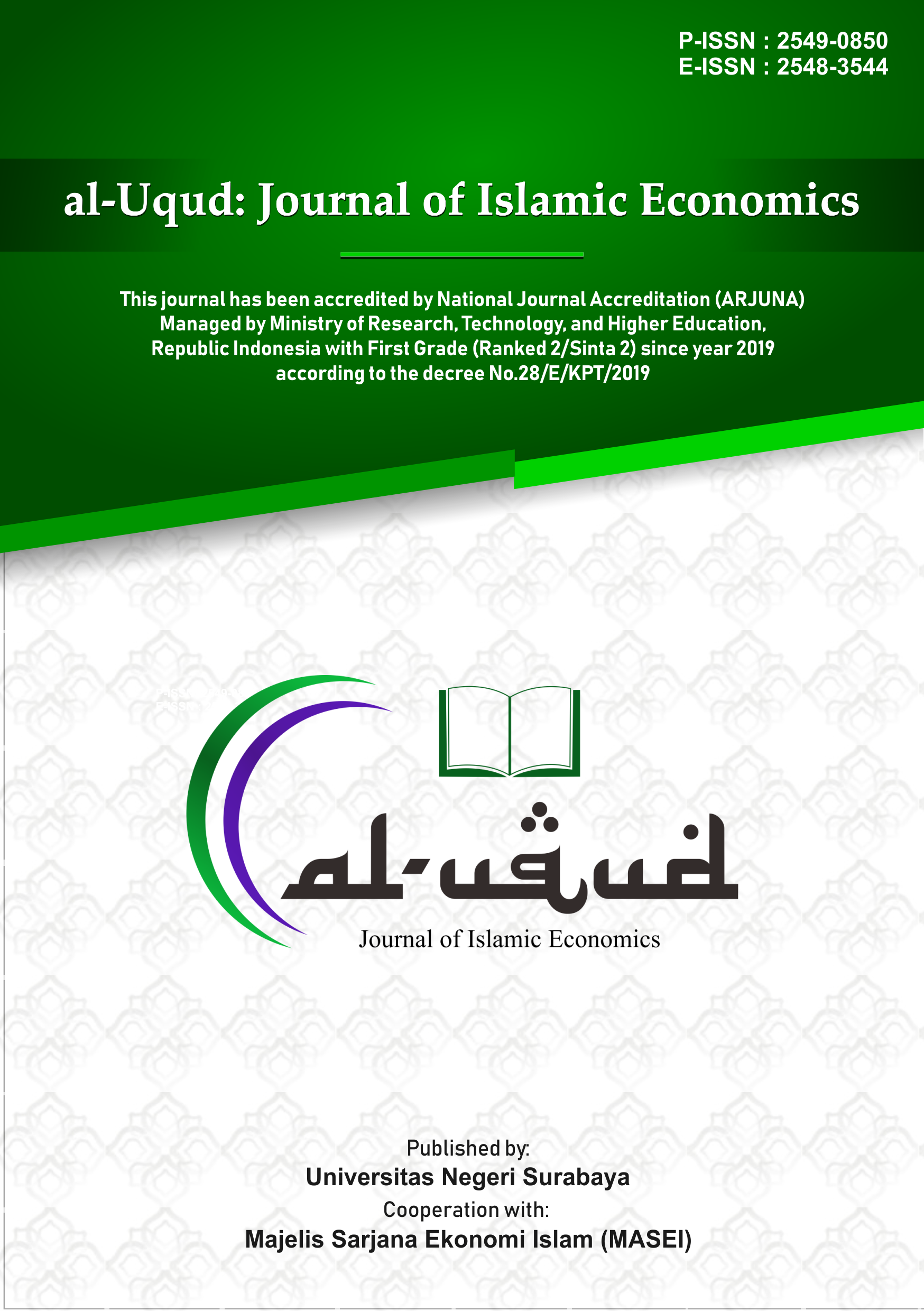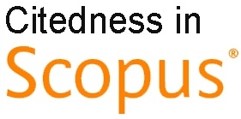How Islamic Bank Managing Risk? An Emphasis on Anticipating Financial Crisis
DOI:
https://doi.org/10.26740/al-uqud.v4n2.p208-217Keywords:
Macroeconomic variable, Financing, SVAR, Pro-cyclicalAbstract
The global economic crisis in 2008 shocked and pressured Indonesian macroeconomic and financial system stability. The decline in macroeconomic stability has an impact on banking policy in lending. Most banks in the world respond to the crisis by doing credit rationing, but how about Islamic bank response toward this condition in Indonesia? Therefore, this study aims to examine the effect of Capital Adequacy Ratio (CAR) and macroeconomic variables on the amount of Islamic banking financing in Indonesia. The method used in this study is the SVAR (Structural Vector Auto Regression) analysis method. The results showed that inflation, capital, and CAR variables had a significant effect on Islamic banks financing amount. In contrast, GDP had no significant impact on Islamic banks financing amount which means that Islamic banking in Indonesia was not implemented pro-cyclical based lending policy.
References
Alqahtani, F., Mayes, D. G., & Brown, K. (2017). Reprint of Economic turmoil and Islamic banking: Evidence from the Gulf Cooperation Council. Pacific-Basin Finance Journal, 42, 113125. https://doi.org/https://doi.org/10.1016/j.pacfin.2016.06.013
Amisano, G., & Giannini, C. (2012). Topics in structural VAR econometrics. Springer Science & Business Media.
Ascarya, Rahmawati, S., & Karim, A. A. (2016). Testing of the Procyclicality of Islamic and Conventional Banks in Indonesia. Macroprudential Regulation and Policy for the Islamic Financial Industry, October 2015, 133152. https://doi.org/10.1007/978-3-319-30445-8_8
Aysan, A. F., & Ozturk, H. (2018). Does Islamic banking offer a natural hedge for business cycles? Evidence from a dual banking system. Journal of Financial Stability, 36, 2238. https://doi.org/10.1016/j.jfs.2018.02.005
Baskaya, Y. S., di Giovanni, J., Kalemli-Özcan, Ş., Peydro, J. L., & Ulu, M. F. (2017). Capital flows and the international credit channel. In Journal of International Economics (Vol. 108, pp. S15S22). https://doi.org/10.1016/j.jinteco.2016.12.003
Beck, T., Demirgüç-Kunt, A., & Merrouche, O. (2010). Islamic vs. conventional banking: Business model, efficiency and stability. The World Bank.
Bitar, M., Kabir Hassan, M., & Hippler, W. J. (2018). The determinants of Islamic bank capital decisions. Emerging Markets Review, 35, 4868. https://doi.org/10.1016/j.ememar.2017.12.002
Bourkhis, K., & Nabi, M. S. (2013). Islamic and conventional banks soundness during the 20072008 financial crisis. Review of Financial Economics, 22(2), 6877.
Çatik, A. N., & Karaçuka, M. (2012). The bank lending channel in Turkey: has it changed after the low-inflation regime? Applied Economics Letters, 19(13), 12371242. https://doi.org/10.1080/13504851.2011.619479
Chavan, P., & Gambacorta, L. (2019). Bank lending and loan quality: an emerging economy perspective. Empirical Economics, 57(1), 129. https://doi.org/10.1007/s00181-018-1436-5
Čihák, M., & Hesse, H. (2010). Islamic banks and financial stability: An empirical analysis. Journal of Financial Services Research, 38(23), 95113.
Cowling, M. (2010). The role of loan guarantee schemes in alleviating credit rationing in the UK. Journal of Financial Stability, 6(1), 3644.
Demirbas, E. (2017). Macroeconomic Impact of 2008 Financial Crisis on Countries by Income Groups. Nile Journal of Business and Economics, 2(4), 5769.
Fakhfekh, M., & Hachicha, N. (2014). Return volatilities and contagion transmission between Islamic and conventional banks throughout the subprime crisis: evidence from the DCC-MGARCH model. International Journal of Managerial and Financial Accounting 2, 6(2), 133145.
Fakhri, K. (2017). Regulatory capital and stability of Islamic and conventional banks. International Journal of Islamic and Middle Eastern Finance and Management, 10(3), 312330. https://doi.org/10.1108/IMEFM-06-2016-0079
Foos, D., Norden, L., & Weber, M. (2010). Loan growth and riskiness of banks. Journal of Banking & Finance, 34(12), 29292940.
FungáÄová, Z., Herrala, R., & Weill, L. (2013). The influence of bank ownership on credit supply: Evidence from the recent financial crisis. Emerging Markets Review, 15, 136147.
Ghosh, A. (2015). Banking-industry specific and regional economic determinants of non-performing loans: Evidence from US states. In Journal of Financial Stability (Vol. 20, pp. 93104). https://doi.org/10.1016/j.jfs.2015.08.004
Ghosh, S. (2013). Funding structure, procyclicality and lending: evidence from GCC banks. Review of Middle East Economics and Finance, 9(2), 241270.
HASAN, M., & DRIDI, J. (2011). the Effects of the Global Crisis on Islamic and Conventional Banks: a Comparative Study. Journal of International Commerce, Economics and Policy, 02(02), 163200. https://doi.org/10.1142/s1793993311000270
Hasan, M. M., & Dridi, J. (2010). The effects of the global crisis on Islamic and conventional banks: A comparative study. IMF Working Papers, 146.
Ibrahim, M. H. (2016). Business cycle and bank lending procyclicality in a dual banking system. Economic Modelling, 55, 127134.
Ibrahim, M. H., & Rizvi, S. A. R. (2018). Bank lending, deposits and risk-taking in times of crisis: A panel analysis of Islamic and conventional banks. Emerging Markets Review, 35, 3147.
İncekara, A., & Çetinkaya, H. (2019). Liquidity Risk Management: A Comparative Analysis of Panel Data Between Islamic And Conventional Banking In Turkey. Procedia Computer Science, 158, 955963. https://doi.org/10.1016/j.procs.2019.09.136
Jeong, H. (2010). The procyclicality of bank lending and its funding structure: The case of Korea.
Jordà , Ò., Schularick, M., & Taylor, A. M. (2011). Financial Crises, Credit Booms, and External Imbalances: 140 Years of Lessons. IMF Economic Review, 59(2), 340378. https://doi.org/10.1057/imfer.2011.8
Kabir, M. N., Worthington, A., & Gupta, R. (2015). Comparative credit risk in Islamic and conventional bank. Pacific-Basin Finance Journal, 34, 327353.
Kang, D., & Mason, A. (2016). Macroprudential Regulation of International Finance: Managing Capital Flows and Exchange Rates. Edward Elgar Publishing.
Khediri, K. Ben, Charfeddine, L., & Youssef, S. Ben. (2015). Islamic versus conventional banks in the GCC countries: A comparative study using classification techniques. Research in International Business and Finance, 33, 7598.
Kupiec, P. H., Lee, Y., & Rosenfeld, C. (2013). Macroprudential policies and the growth of bank credit. American Enterprise Institute Working Paper, 8.
Leroy, A., & Lucotte, Y. (2019). Competition and credit procyclicality in European banking. In Journal of Banking and Finance (Vol. 99, pp. 237251). https://doi.org/10.1016/j.jbankfin.2018.12.004
Lin, H.-Y., Farhani, N. H., & Koo, M. (2016). The Impact of Macroeconomic Factors on Credit Risk in Conventional Banks and Islamic Banks: Evidence from Indonesia. International Journal of Financial Research, 7(4), 105116.
Louati, S., Abida, I. G., & Boujelbene, Y. (2015). Capital adequacy implications on Islamic and non-Islamic banks behavior: Does market power matter? Borsa Istanbul Review, 15(3), 192204.
Shaw, M., Chang, J., & Chen, H.-J. (2013). Capital adequacy and the bank lending channel: Macroeconomic implications. Journal of Macroeconomics, 36, 121137.
Yuanyan, Z. (2017). Effectiveness and channels of macroprudential policies: lessons from the Euro area. Journal of Financial Regulation and Compliance, 25(3), 271306. https://doi.org/10.1108/JFRC-10-2016-0094
Downloads
Published
How to Cite
Issue
Section
License
CC BY 4.0 Abstract views: 1013
,
Abstract views: 1013
, PDF Downloads: 641
PDF Downloads: 641








